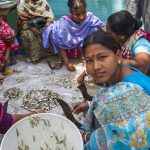Upon request of the U.S. Agency for International Development (USAID), IFPRI conducted this study to support USAID in assessing the state of empowerment and gender parity of men and women along the agricultural value chain in the Feed the Future (FTF) Zone of Influence (ZOI) in Bangladesh. Specifically, IFPRI’s Policy Research and Strategy Support Program […]
In Bangladesh, IFPRI’s national household survey data show positive changes in women’s empowerment in the USAID-supported Feed the Future Zone of Influence (FTF ZOI) between 2012 and 2015; however, these findings only apply to agricultural production because other areas of empowerment were not measured. It is possible that FTF programming may have had spillover effects on women’s empowerment in agriculture-based rural enterprises as well as the nonfarm sector, but this would not have been captured by the existing Women’s Empowerment in Agriculture Index (WEAI), which measures empowerment. The need to develop a metric to enable a better understanding of empowerment in other nodes of the value chain, such as entrepreneurship and wage-earning activities, motivated the development of a new index, the WEAI for Value Chains (WEAI4VC).
IFPRI conducted the Women’s Empowerment in Agriculture Index for Value Chains (WEAI4VC) study to support assess the state of empowerment and gender parity of men and women along the agricultural value chain in the USAID-supported Feed the Future Zone of Influence (FTF ZOI) in Bangladesh. Specifically, IFPRI’s Policy Research and Strategy Support Program (PRSSP) piloted the modified Women’s Empowerment in Agriculture Index (WEAI) survey instruments in 10 upazilas (sub-districts) within the FTF ZOI across 1,200 households, which broadly belong to three economic activities of interest: (1) agricultural production, (2) agricultural entrepreneurship, and (3) agricultural sector employment.
WEAI4VC Survey Enumerator Training
WEAI4VC, a pilot project led jointly by IFPRI and USAID, aims to improve our understandings of how empowerment varies along the agricultural value chain.

